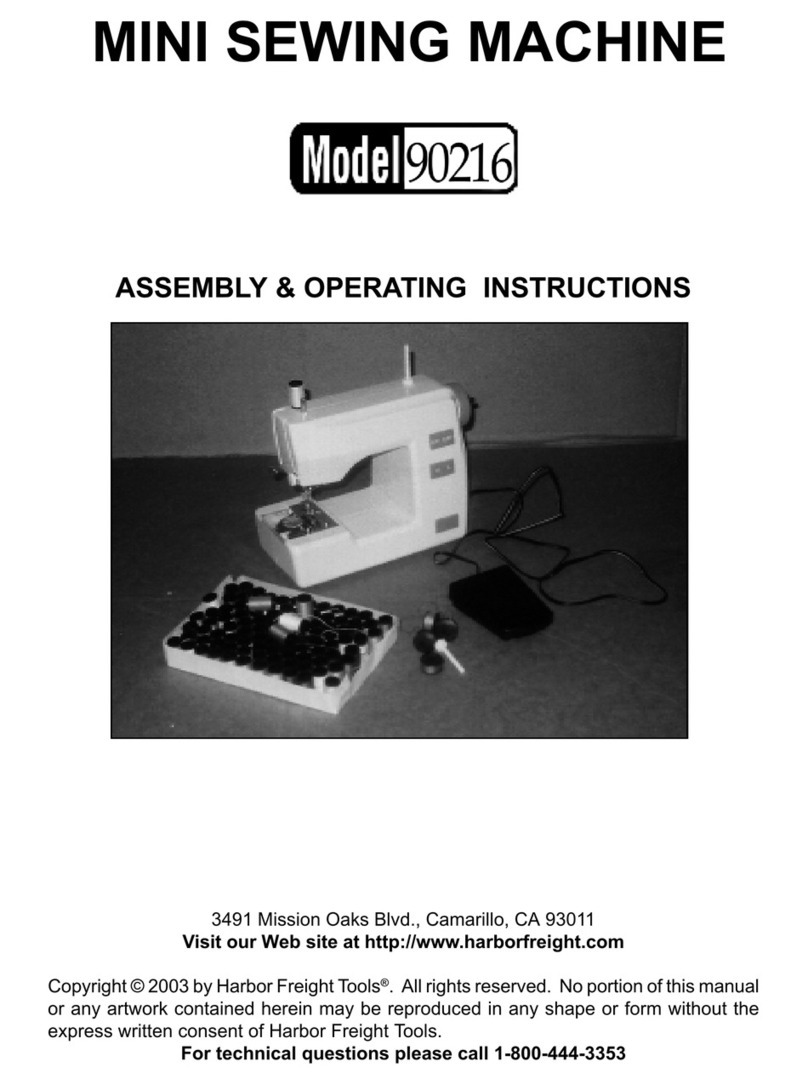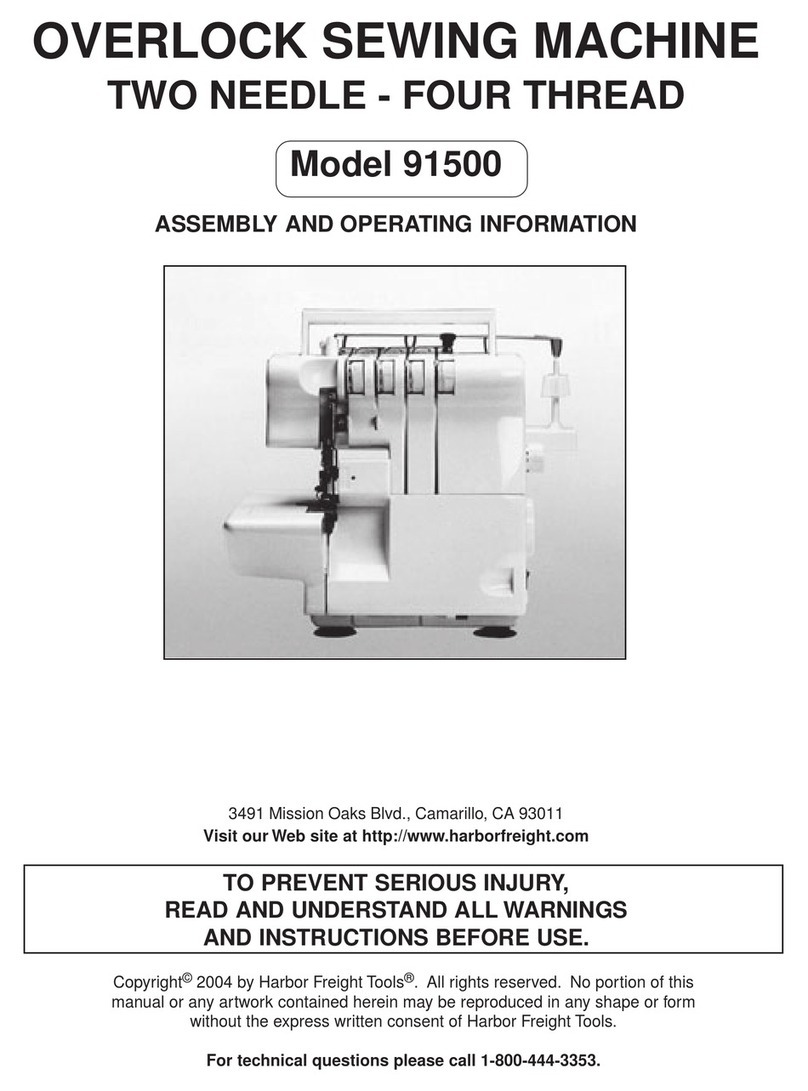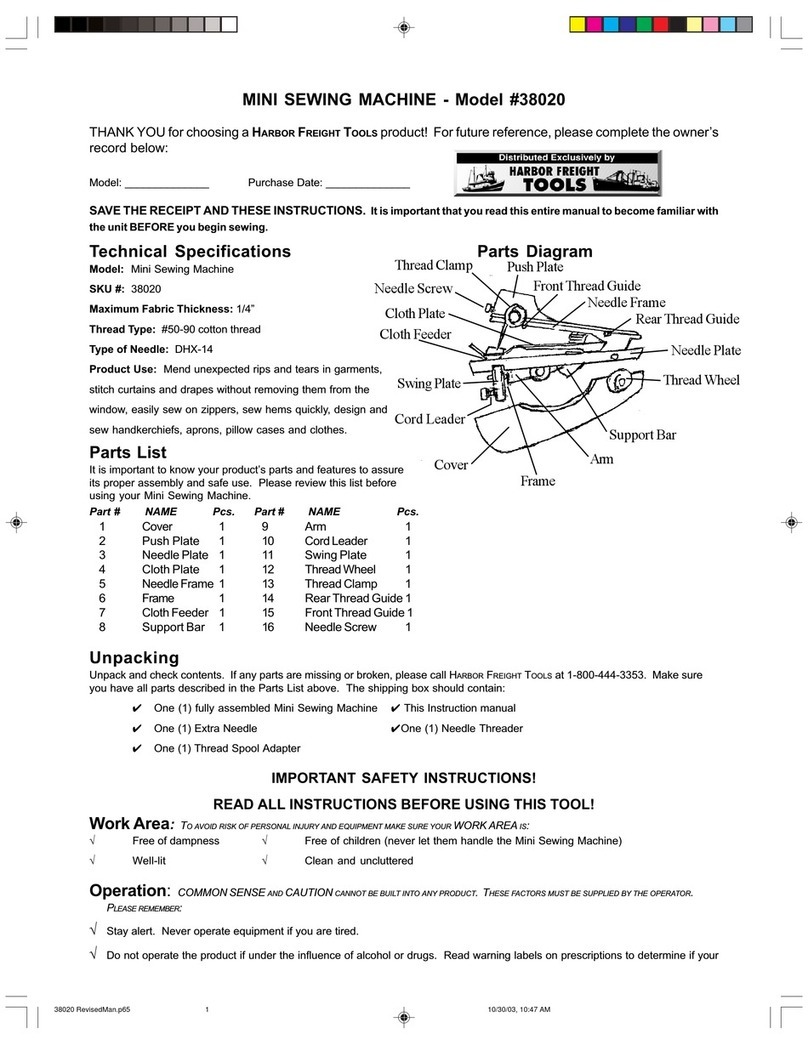Harbor Freight Tools 3914 User manual

SEWING MACHINE - SINGLE NEEDLESEWING MACHINE - SINGLE NEEDLE
SEWING MACHINE - SINGLE NEEDLESEWING MACHINE - SINGLE NEEDLE
SEWING MACHINE - SINGLE NEEDLE
ASSEMBLY AND OPERATING INSTRUCTIONS
3491 Mission Oaks Blvd., Camarillo, CA 93011
Visit ourWeb site at http://www.harborfreight.com
Copyright © 2003 by Harbor Freight Tools®. All rights reserved. No portion of
this manual or any artwork contained herein may be reproduced in any shape
or form without the express written consent of Harbor Freight Tools.
For technical questions and replacement parts,please call 1-800-444-3353
03914

Page 2SKU 03914
Specifications
ITEM DESCRIPTION
Machine Type Heavy duty, industrial sewing machine; high
speed, single needle-lock stitch
Drive V-belt driven
Action Foot pedal operation, along with a knee and
manual lifting arm for presser foot. Presser
tension adjustment
Sewing Thickness 5/16 inch maximum
Feed Type Link style needle feed reduces slippage
Sewing Directions Forward and reverse feed
Stitching Speed 5500 Stitches per minute
Motor Type Clutch motor; 3450 RPM, 5.8 amps, 110 VAC at
60 Hz; single phase
Overall weight 61.6 lbs
Machine Dimensions 20-3/4 (L) x 10 (H) inches
Accessories
- Screwdrivers
- 3 Bobbins
- Small lubricating bottle with tip
- 10 pack of needles
- Power Switch
Table Stand Kit Table Stand Kit (Model 03929) not included
Save This Manual
You will need the manual for the safety warnings and precautions, assembly instructions,
operating and maintenance procedures, parts list and diagram. Keep your invoice with this
manual. Write the invoice number on the inside of the front cover. Keep the manual and
invoice in a safe and dry place for future reference.
Safety Warnings and Precautions
WARNING:When using tool, basic safety precautions should always be followed to re-
duce the risk of personal injury and damage to equipment.
Read all instructions before using this tool!
1. Keep work area clean. Cluttered areas invite injuries.
2. Observe work area conditions. Do not use machines or power tools in damp or wet
locations. Don’t expose to rain. Keep work area well lighted. Do not use electrically
powered tools in the presence of flammable gases or liquids.
3. Keep children away. Children must never be allowed in the work area. Do not let
them handle machines, tools, or extension cords.
4. Store idle equipment. When not in use, tools must be stored in a dry location to
inhibit rust. Always lock up tools and keep out of reach of children.
Rev 04/03 REV 05/03 REV 03/04
Caution: Make certain that the voltage switch on the motor is set correctly
for your use. See page 6.
This Machine requires oil to be added before use -see page 6 for details.
110/220V,

Page 3SKU 03914
5. Use the right product for the job.Do not attempt to force a small product or
attachment to do the work of a larger industrial tool.There are certain applications for
which this product was designed.It will do the job better and more safely at the rate
for which it was intended.Do not modify this product and do not use this product for a
purpose for which it was not intended.
6. Dress properly. Do not wear loose clothing or jewelry as they can be caught in
moving parts. Protective, electrically non-conductive clothes and non-skid footwear
are recommended when working. Wear restrictive hair covering to contain long hair.
7. Do not overreach. Keep proper footing and balance at all times. Do not reach over
or across running machines.
8. Maintain tools with care. Keep tools sharp and clean for better and safer
performance. Follow instructions for lubricating and changing accessories. Inspect
tool cords periodically and, if damaged, have them repaired by an authorized
technician.The handles must be kept clean, dry, and free from oil and grease at all
times.
9. Disconnect power.Unplug product when not in use.
10. Remove adjusting keys and wrenches. Check that keys and adjusting wrenches
are removed from the machine work surface before plugging it in.
11. Avoid unintentional starting. Be sure the switch is in the Off position when not in
use and before plugging in.
12. Stay alert. Watch what you are doing, use common sense. Do not operate when you
are tired.
13. Check for damaged parts. Before using any product, any part that appears
damaged should be carefully checked to determine that it will operate properly and
perform its intended function. Check for alignment and binding of moving parts; any
broken parts or mounting fixtures; and any other condition that may affect proper
operation. Any part that is damaged should be properly repaired or replaced by a
qualified technician. Do not use if any switch does not turn On and Off properly.
14. Guard against electric shock. Prevent body contact with grounded surfaces such
as pipes, radiators, ranges, and refrigerator enclosures.
15. Replacement parts and accessories. When servicing, use only identical
replacement parts.Use of any other parts will void the warranty. Only use accessories
intended for use with this tool. Approved accessories are available from Harbor
Freight Tools.
16. Do not operate tool if under the influence of alcohol or drugs. Read warning
labels if taking prescription medicine to determine if your judgment or reflexes are
impaired while taking drugs. If there is any doubt, do not operate the tool.

Page 4SKU 03914
17. Use proper size and type extension cord. If an extension cord is required, it must be
of the proper size and type to supply the correct current to the tool without heating up.
Otherwise, the extension cord could melt and catch fire, or cause electrical damage to
the tool.This tool requires use of an extension cord with up to 10 amps capability (up
to 50 feet), with wire size rated at 18 AWG.Longer extension cords require larger size
wire. If you are using the tool outdoors, use an extension cord rated for outdoor use.
(signified by “WA” on the jacket).
20. Maintenance. For your safety, service and maintenance should be performed
regularly by a qualified technician.
21. Pacemaker safety warning. People with pacemakers should consult with their
physician(s) before using this product; operation of equipment in close proximity to a
heart pacemaker could cause interference or failure of the pacemaker.
Note: Performance of this tool may vary depending on variations in local line voltage.Exten-
sion cord usage may also affect tool performance.
Warning:The warnings, cautions,and instructions discussed in this instruction manual
cannot cover all possible conditions and situations that may occur. It must be under-
stood by the operator that common sense and caution are factors which cannot be
built into this product, but must be supplied by the operator.
Sewing Safety Precautions
1. Keep hands away from the needle when you turn the power switch on, or while the
machine is operating.
2. Do not place your fingers into the thread take-up cover while the machine is
operating.
3. Always turn the machine off and unplug the power cord to the electrical outlet before
tilting the machine head or removing the V-belt.
4. Never leave the machine running and unattended.
5. During operation, never place your head, hair, or hands in the proximity of the hand
wheel, V-belt, bobbin winder, or motor.
6. Do not operate the machine with any safety guards removed.
Unpacking
When unpacking, check to make sure that the parts shown in the photo on the following
page are included. Note that the machine table shown is not included, and must be ordered
separately. If any parts are missing or broken, please call Harbor Freight Tools at the num-
ber on the cover of this manual as soon as possible.

Page 5SKU 03914
Assembly
The assembly instructions describe mounting the Single-Needle Sewing Machine (Model
03914) to the Table Stand (Model 03929), not included.In order to complete this procedure,
you must first purchase and assemble the Table Stand Kit (Model 03929).
1. Locate four corner rests in the rectangular hole of the Table Stand where the machine
will sit.
2. Place two rubber seats (A) on the operator-side, corner rests and secure with
supplied hardware (C).See figure 1.
3. Place two cushion seats (B) on the hinge-side, corner rests and secure with supplied
hardware (C).
4. Seat the Oil Pan (D) on the corner seats (A) and (B). See figure 2.
5. Insert Hinges (E) into the opening in the machine bed. See figure 3.
Sewing Machine
Motor
Power Switch
Knee Lifting Arm
for Presser Foot
Table Stand and
Top (not provided)
Table of contents
Other Harbor Freight Tools Sewing Machine manuals




















